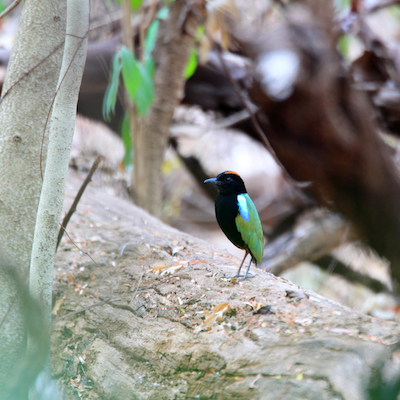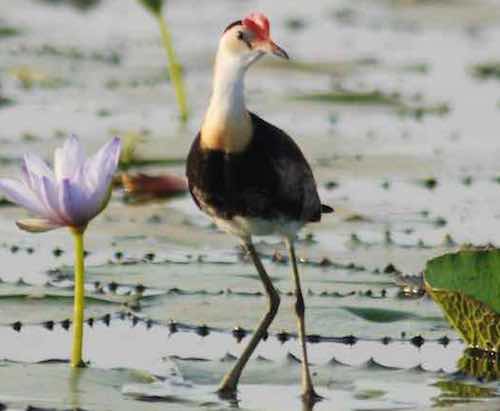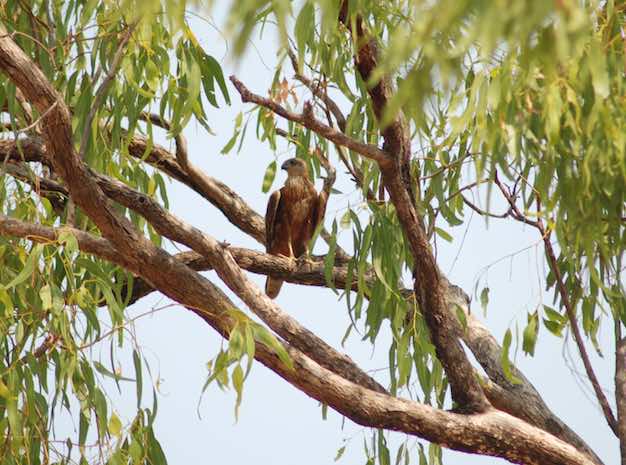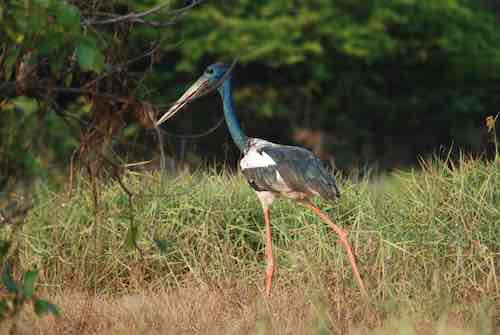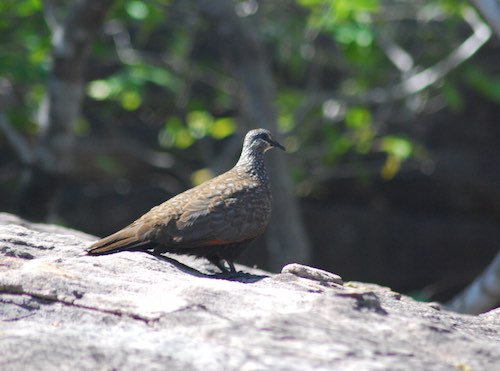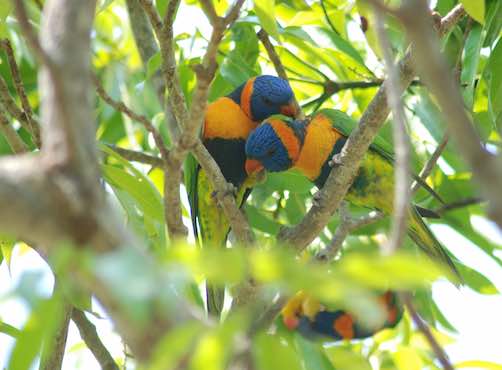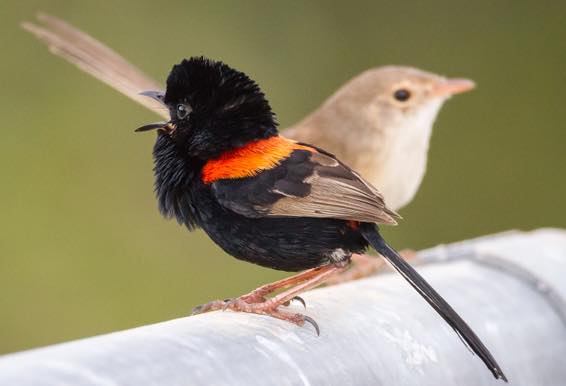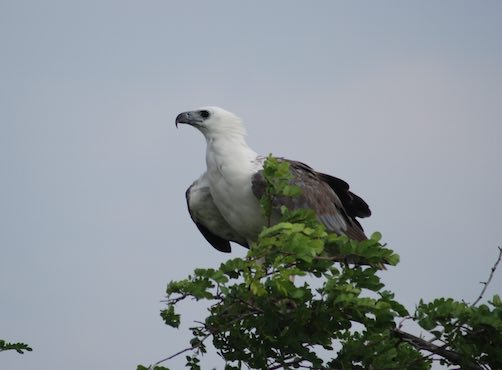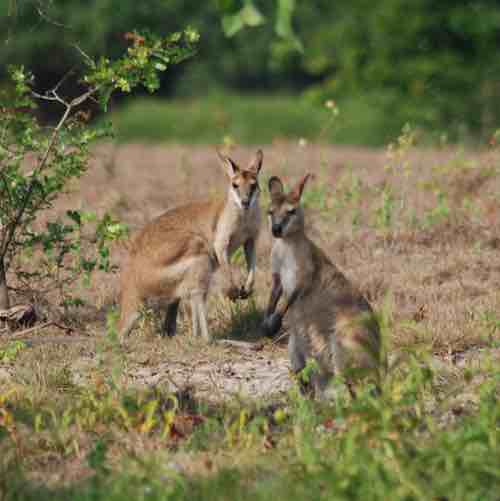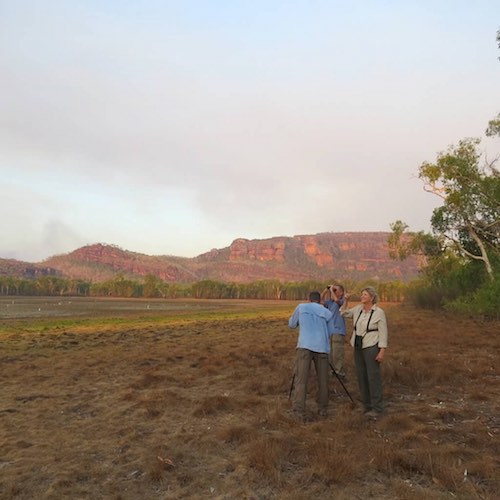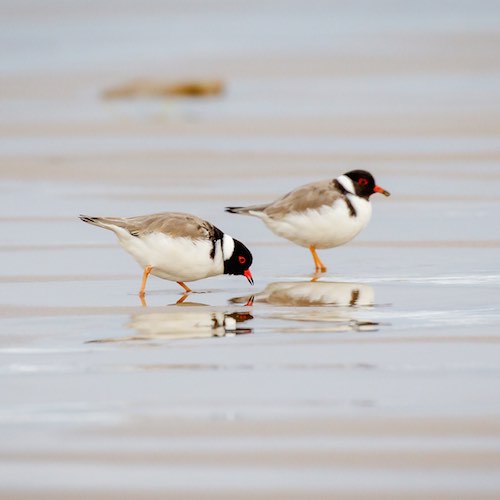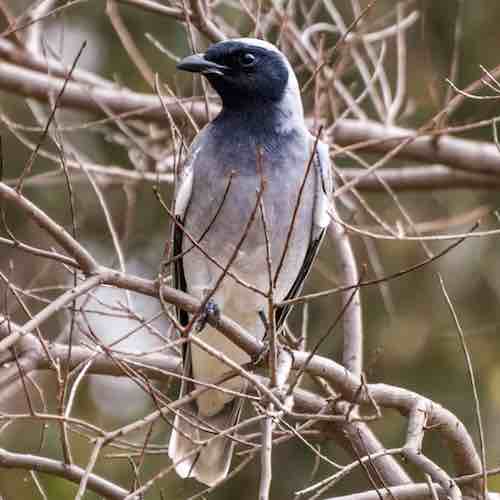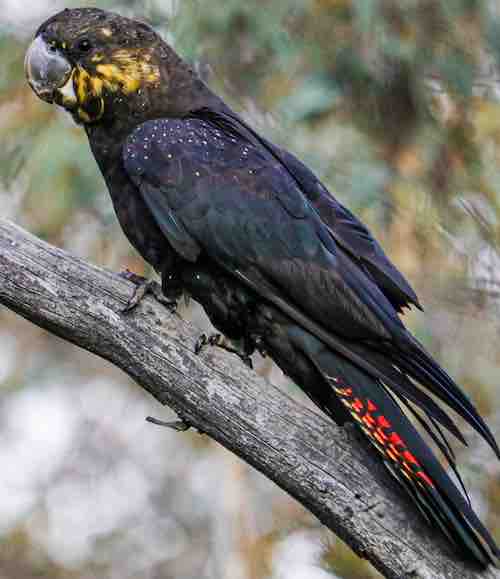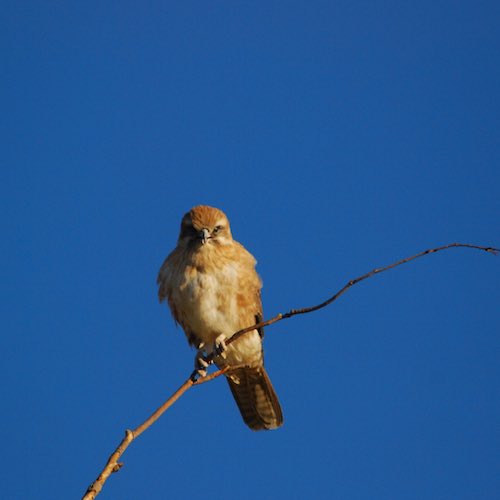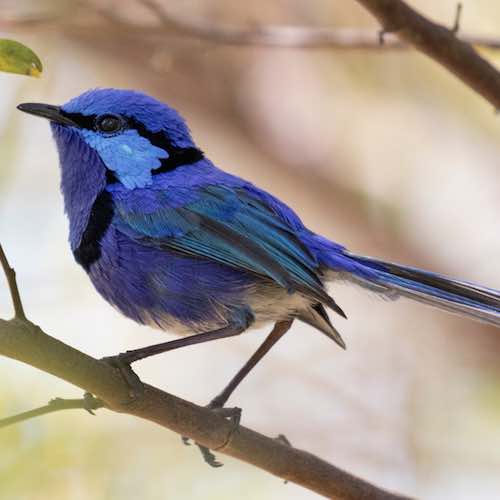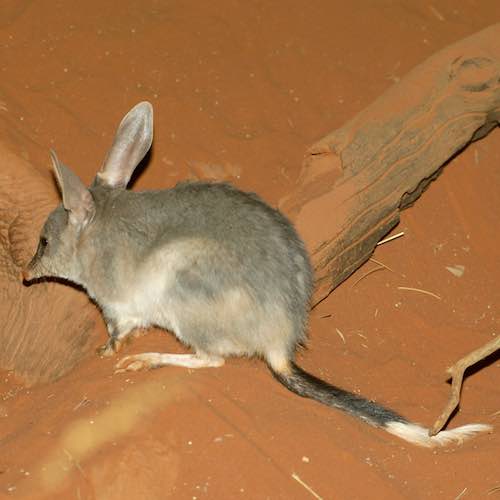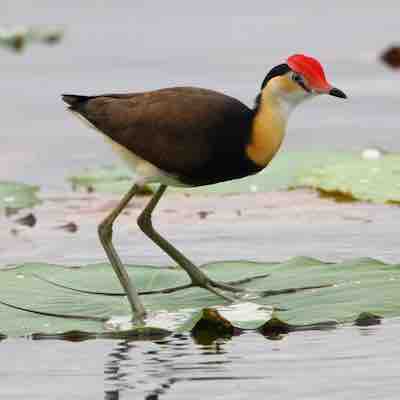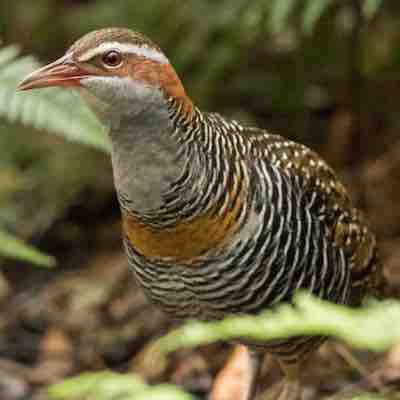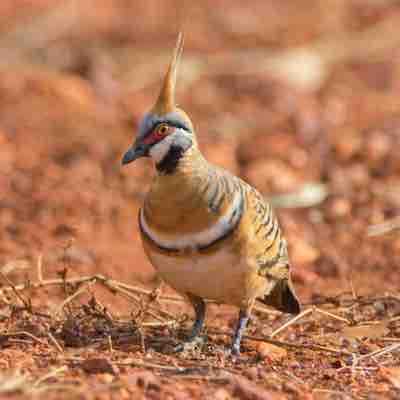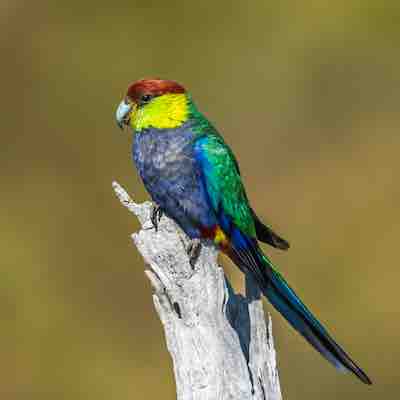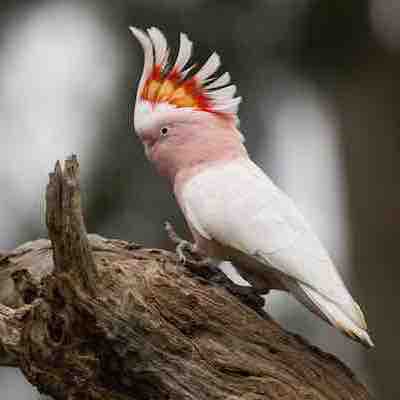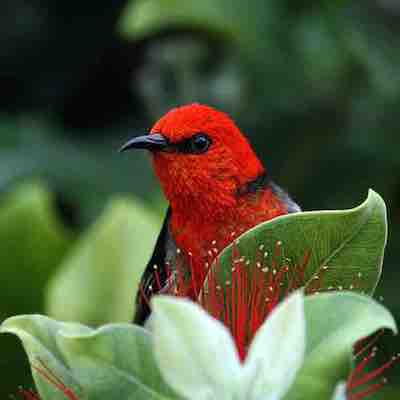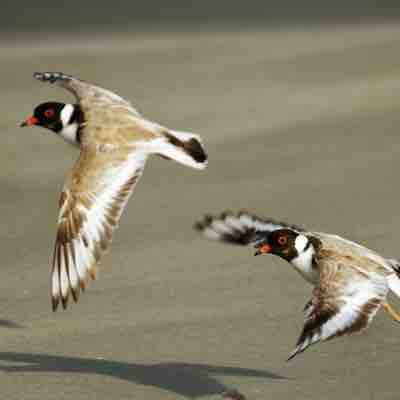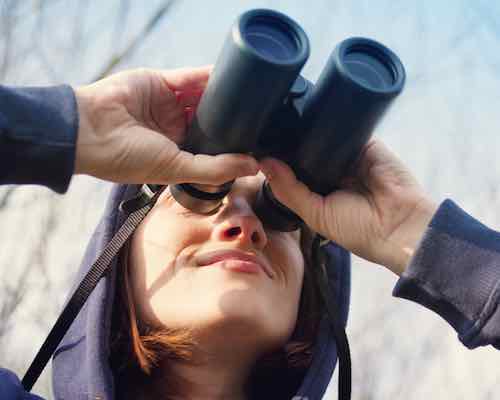Birding - Northern Territory
Top End
Home of eleven endemics and we find them all plus many other birds temperate rainforests, national parks, tall cliffs, low bushland you find birds anywhere. Well worth a visit for both birds and the scenery.
Full Day Birding in Darwin, Fogg Dam & Surrounds
This Full-Day Tour is the best way to see some of the 300-plus recorded birds of Darwin and surrounds. The tour ventures beyond Darwin and visits the bird-rich wetlands of Fogg Dam Conservation Reserve. You also visit the Adelaide River and Mary River regions for a chance to see species not found in Darwin such as the endangered Gouldian Finch.
Whether you’re a beginner, an enthusiastic twitcher or a qualified ornithologist your birding guide will show you some of the 300-plus species recorded of Darwin and surrounds - from the Red-necked Avocet to the Zitting Cisticola and everything in between.
The Full-Day Tour takes you to habitats rich in bird-life within and outside Darwin. You will visit monsoon rainforest in search of the endemic Rainbow Pitta and colourful Rose-crowned Fruit-Dove; coastal foreshores in search of shorebirds, Sacred Kingfisher and Beach Stone-curlew; mangroves for Redheaded Honeyeater, Collared Kingfisher and Chestnut Rail; wetlands and billabongs for a variety of water birds including the iconic Black-necked Stork (Jabiru) and Brolga; and savannah woodland for Blue-winged Kookaburra, Red-backed Kingfisher and the endangered Gouldian Finch.
Tour Cost: Min 3 guests, Max 8 guests. Private tours available. Tour operates daily, subject to availability.
Tour Code: BD1DS
To add this tour to your itinerary enquiry, please include the tour code.
Tour Code: BD1DS
Important Information
Hotel Pick-up: 7 am / Hotel Drop-off: 6 pm
Inclusions: Use of binoculars & spotting scope, sunscreen & drinking water, & lunch.
Due to the seasonal nature of the Top End, some habitat types may not be accessible on the day of your tour.
Each tour involves some driving in a comfortable, fully equipped 4WD as well as short walks and requires a good level of mobility and moderate fitness. Due to the seasonal nature of the Top End some habitat types may not be accessible on the day of your tour.
2 Day / 1 Night Kakadu Birding Tour - from Darwin
Day 1: Darwin to Kakadu National Park
Depart Darwin early this morning on a private birding tour to Kakadu National Park. Travel from Darwin to the Mary River region where we have a chance to see the rare and endangered Gouldian Finch. Additional species include Crimson, Masked, Long-tailed and Double-barred Finches, Rufous Whistler, Red-tailed Black Cockatoo and Great Bowerbird.
We cross over the South Alligator River floodplains on the lookout for Spotted Harrier, and Golden-headed Cisticola. Then to Mamukala wetlands for wetland birds including Plumed and Wandering Whistling Ducks, Magpie Goose, Green Pygmy-goose and Comb-crested Jacana, and woodland birds such as Buff-sided Robin and Black-eared Cuckoo and birds of prey such as Black-breasted Buzzard and Square-tailed Kite.
After lunch in Jabiru (own expense, a walk on the Manngarre Walk on the East Alligator River in search of rainforest species such as Little Shrike-thrush, Rose-crowned Fruit-Dove, and Rainbow Pitta.
We then drive to Ubirr in search of the sandstone endemics of the Arnhem escarpment. On the way we hope to encounter Partridge Pigeon crossing the road.
Walk atop Ubirr in search of Whitelined Honeyeater, Sandstone Shrike-thrush and Chestnut-quilled Rock-Pigeon. We have the opportunity to view and learn about the ancient Aboriginal rock art at this site.
Day 2 – Cooinda, Kakadu National Park to Darwin
A dawn Yellow Water Cruise (2 hrs) gives us the chance for wetland birds such as the secretive Great-billed Heron and Black Bittern, Flycatchers and Azure and Little Kingfishers. The rare and endangered Red Goshawk has been seen in this region.
After breakfast visit Burrungkuy (Nourlangie) rock art site to view an ancient Aboriginal shelter and Aboriginal rock art. This is another great area for the sandstone species including Chestnut-quilled Rock-Pigeon, Sandstone Shrike-thrush, White-lined Honeyeater and Banded Fruit-Dove as well as ‘Sandstone Friarbird’ – a sub-species of the Helmeted Friarbird.
Lunch at your own expense in Jabiru.
After lunch, we depart Kakadu National Park and visit Fogg Dam Conservation Reserve for an abundance of waterbirds including Brolga, Jabiru, White-browed Crake and Buff-banded Rail.
Return to Darwin at around 6.30pm.
Private tour – April to November and subject to availability of birding guide.
Tour Code: BD2KP
To add this tour to your itinerary enquiry, please include the tour code.
Important Information
Inclusions: Road transportation, expert bird guiding of the region, Kakadu National Park entry fee, accommodation, breakfast. Yellow Water cruise, morning tea, cold drinks and drinking water.
Accommodation: from 3 star to 4.5 star.
Pricing: On application valid April to November 2015. Tour departs daily on request, and availability of guide.
Tour Code: BD4KP
To Book or Enquire: Email (Please include Tour Code)
4 Day / 3 Night Mary River, Kakadu & Pine Creek Birding Tour – from Darwin
Day 1 – Darwin to Mary River
Pick-up Darwin accommodation for the start of your tour. We will visit the mangroves of Darwin in search of the secretive Chestnut Rail (tides permitting). We hope to encounter several mangrove species including Red-headed Honeyeater, Collared Kingfisher, Black Butcherbird, Yellow White-eye, Mangrove Golden Whistler and Green-backed Gerygone.
Visit Fogg Dam Conservation Reserve for morning tea and an abundance of waterbirds including Brolga, Jabiru, White-browed Crake and Buff-banded Rail.
Continue for a drive along the Marrakai Track for woodland species such as Black-tailed Treecreeper, Varied Sitella, Gouldian Finch and Red-backed Kingfisher, followed by a picnic lunch in the Mary River region where Gouldian Finches have been known to visit.
In the afternoon search for Barking Owl, Partridge Pigeon, Northern Rosella, as well as Buff-sided Robin. Additional species include Black Bittern, Crimson, Masked, Long-tailed and Double-barred Finches, Rufous Whistler, Red-tailed Black Cockatoo and Great Bowerbird.
Later join a cruise on Mary River and look for Black Bittern, Great-billed Heron, white morph of Grey Goshawk, and Pacific Baza. You are also likely to see saltwater and freshwater crocodiles.
Overnight at Mary River Wilderness Retreat.
Day 2 – Mary River to Kakadu
An early start this morning to try and see Gouldian Finches before departing Mary River Park after breakfast and travelling towards Kakadu National Park. En route we will search for rainforest species then to the South Alligator River floodplains for Yellow Chat, Spotted Harrier, Letter-winged Kite and Golden-headed Cisticola.
The Mamukala wetlands provide excellent viewing of wetland birds including Plumed and Wandering Whistling Ducks, Magpie Goose, Green Pygmy-goose and Comb-crested Jacana, as well as woodland birds such as Buff-sided Robin and Black-eared Cuckoo and birds of prey such as Black-breasted Buzzard and Square-tailed Kite.
After lunch, drive to Ubirr to search for the sandstone endemics of the Arnhem escarpment. On the way we hope to encounter Partridge Pigeon crossing the road. Walk atop Ubirr in search of Whitelined Honeyeater, Sandstone Shrike-thrush and Chestnut-quilled Rock-Pigeon. We have the opportunity to view and learn about the ancient Aboriginal rock art at this site.
We will continue to the Bardedjilidji Walk to increase our chances of the sandstone endemics. Rainbow Pitta also resides in this area.
Return to Jabiru keeping an eye out for the nocturnal birds such as Spotted and Large-tailed Nightjars, Australian Owlet-nightjar, Tawny Frogmouth, Barking and Rufous Owls.
Overnight Kakadu National Park
Day 3 – Kakadu to Pine Creek
An early morning cruise on Yellow Water Billabong will provide us with great opportunities for wetland birds, Flycatchers, Azure and Little Kingfishers. Whistling Duck and Magpie Goose are abundant.
After lunch, depart for Gunlom Falls in the south-west area of Kakadu National Park to see stunning views of southern Kakadu and swim in escarpment pools or in the natural plunge pool at the base of the falls. There are opportunities for Galah, Varied Triller, Northern Rosella, Crimson Finch, White-throated Honeyeater and Brown Falcon.
Depart Gunlom and travel out of Kakadu National Park to the small town of Pine Creek for overnight. The Pine Creek Water Gardens (time permitting) attract a number of species including Hooded Parrot, Great Bowerbird and Red-winged Parrot.
Overnight at Pine Creek.
Day 4 – Pine Creek to Darwin
An early rise this morning to visit Leliyn (Edith Falls) for another chance to see Hooded Parrot and Gouldian Finch. Then visit the sewage ponds at Pine Creek. Several bird species are to be found in the vicinity but one regular is the little Black-fronted Dotterel which breeds here. Finches - Masked, Long-tailed and Double-barred are common as is Red-backed Fairy-wren. Cockatiel, Hooded Parrot, Red-winged Parrot, Red-tailed Black Cockatoo and two species of woodswallow may also be seen. There may also be an opportunity to catch a glimpse of Gouldian Finch in this area. Also found throughout the area in suitable habitat is the endemic Partridge Pigeon.
In the afternoon, travel north west on the Stuart Highway and return to Darwin via Adelaide River with an opportunity to look for Varied Lorikeet and Red-tailed Black Cockatoo.
Private tour – April to November and subject to availability of birding guide.
Tour Code: BD4KP
To add this tour to your itinerary enquiry, please include the tour code.
8 Day/ 7 Night Kakadu & Kangaroo Island Private Birdwatching Tour – from Darwin
This tour is designed for all birders (twitchers and newcomers!) to see a large number of species in two important regions of Australia – Kakadu National Park in Northern Territory, and Kangaroo Island in South Australia. Kakadu National Park provides a wealth of diverse tropical habitat including forest & creek mangrove, monsoon forest, savannah woodland, sandstone escarpment, shoreline and wetlands.
The Kakadu bird list reflects this diversity with more than 280 species including a number of endemics.
Kangaroo Island provides a temperate habitat for over 240 species including South Australia’s only population of Glossy Black Cockatoo, plus a number of sought-after rare species.
There are a number of National Parks to visit, and some very spectacular coastal scenery. Of course, you will no doubt see many mammals on this tour, including estuarine crocodile, koala, kangaroo, wallaby, echidna and Australian Sea-lion to mention a few. You will travel with very knowledgeable and experienced guides.
Day 01 – Arrive Darwin
Arrive at Darwin Airport transfer to your hotel in Darwin.
Depending on your arrival time, why not begin your Top End birdwatching with a short walk to the Esplanade and into Bicentennial Park. You are likely to see Australian Figbird, Peaceful Dove, Crested Pigeon, Rainbow Lorikeet, Brown Honeyeater and White-bellied Cuckoo-shrike.
Accommodation: Darwin Central Hotel (or similar)
Day 02 – Darwin to Mary River to Jabiru in Kakadu National Park
Enjoy breakfast at your hotel this morning, and check out from your hotel.
Meet your private birding guide for the next three days and depart Darwin for Lee Point (Buffalo Creek) to look for Australasian Figbird, Yellow Oriole, Little Friarbird, Varied Triller, Orange-footed Scrubfowl and Spangled Drongo – with Chestnut Rail a difficult possibility. At Knuckey Lagoon we may see Green Pygmy-goose, Magpie Goose, Egrets, Whiskered Tern and Australian Pratincole.
Then it’s on to Fogg Dam to look for four species of egrets (mainly Intermediate), Black-necked Stork, Brolga, Purple Swamphen and perhaps Banded Land Rail. Comb-crested Jacana are common. Also look for Clamorous Reed-Warbler, Golden-headed Cisticola, Tawny Grassbird and White-browed Crake. Chestnut-breasted Mannikin, Double-barred and Crimson Finch inhabit the pandanus and the reedbeds, and you may see Rainbow Pitta in the dark undergrowth.
On to Mary River Park for a private river cruise, hoping to view Black Bittern, Great-billed Heron and Little Kingfisher.
Then travel into Kakadu National Park where a diverse range of habitats supports more than 280 species of birds and you may see Black and Whistling Kite, Blue-winged Kookaburra, Bush Thick-knee, Chestnut-quilled Rock Pigeon, Comb-crested Jacana, Green Pygmy-goose, Black-necked Stork, Magpie Goose, Partridge Pigeon, Plumed Whistling-duck, Rainbow Bee-eater, Red-collared Lorikeet, Red-tailed Black-cockatoo, Torresian Crow and White-bellied Sea-eagle.
Accommodation: Anbinik Kakadu Resort (or similar)
Day 03 – Kakadu National Park
This morning head to Ubirr (steeped in Aboriginal culture and ancient rock art) to search for the sandstone endemics of the Arnhem escarpment such as White-lined Honeyeater, Sandstone Shrike-thrush and Chestnut-quilled Rock-Pigeon. Partridge Pigeon may be seen on the road. Continue to the Bardedjilidji Walk to increase our chances of the sandstone endemics. Rainbow Pitta also resides in this area.
The Mamukala wetlands provide excellent viewing of wetland birds with possibilities including Plumed and Wandering Whistling Ducks, Magpie Goose, Green Pygmy-goose and Comb-crested Jacana, as well as woodland birds such as Buff-sided Robin and Black-eared Cuckoo and birds of prey such as Black-breasted Buzzard and Square-tailed Kite. Then to Angbangbang Billabong for wetland birds as well as bush birds such as Little Shrike-thrush and Rufous-banded Honeyeater.
We drive to Nourlangie Rock for more paintings in shelters by Aboriginal people, some thought to be over 20,000 years old. The Nourlangie escarpment has many endemics and we hope to see Banded Fruit-dove, Chestnut-quilled Rock-pigeon, White-lined Honeyeater, Silver-crowned Friarbird and the Sandstone race of the Helmeted Friarbird.
On the way to Cooinda we may see nocturnal birds such as Spotted and Large-tailed Nightjars, Australian Owlet-nightjar, Tawny Frogmouth, Barking and Rufous Owls.
Accommodation: Cooinda Lodge Kakadu (or similar)
Day 04 – Kakadu National Park to Darwin
A cruise on the Yellow Water Wetlands to look for Arafura Fantail, Buff-sided Robin, Black Bittern, Oriental Cuckoo, Grey Goshawk and all the wetland birds, saltwater crocodiles, tree snakes, and other wildlife inhabiting the wetlands.
Then visit the Warradjan Aboriginal Cultural Centre where you will learn about the culture, beliefs and lifestyle of the traditional Aboriginal owners.
Return to Darwin this afternoon, stopping along the way for more sightings before arriving at your hotel.
Accommodation: Darwin Central Hotel (or similar)
Day 05 – Darwin to Adelaide to Kangaroo Island
The Remarkables, Kangaroo Island
Transfer to Darwin Airport to check-in for your flight to Adelaide.
Fly Darwin to Adelaide (airfare not included).
On arrival at Adelaide Airport, check in with Regional Express Airlines (also known as REX) for your short flight to Kingscote on Kangaroo Island. Luggage limits apply and storage is available with REX. (This flight included in tour cost).
You will be transferred from Kingscote Airport to your accommodation for three nights.
Accommodation: Mercure Kangaroo Island Lodge (or similar)
Day 06 – Full Day Birding, Kangaroo Island
Meet your birding guide and begin two days exploring this large and diverse Island. At Murray Lagoon common encounters include: Wedge-tailed Eagle, Chestnut-breasted Shelduck, Musk Duck, Black Swan, White-fronted Chat, Richard’s Pipit, Grey Teal, Swamp Harrier, Peregrine Falcon, Red-capped Dotterel, and Black-fronted Dotterel. Summer visits will also include a range of migratory waders. Then to Seal Bay Conservation Park which protects the habitat of a range of wildlife species including Australian sea-lions, and a chance for Hooded Plover, Eastern Osprey, White-bellied Sea-eagle, Crested Tern, Sooty Oystercatcher and a range of bush birds.
At Lathami Conservation Park look for the critically endangered Glossy Black Cockatoo as well as Superb Fairy-wren, Golden Whistler, Crimson Rosellas, Beautiful Firetail, tammar wallabies, echidnas and Kangaroo Island kangaroos. Look for a mix of shore-birds at Cygnet River Estuary, Reeves Point and American River which is a tidal inlet on the northeast coast.
The woodlands above American River provides habitat for the Glossy Black Cockatoo, Galah, Beautiful Firetail, Scarlet Robin and Crimson Rosella. At Pelican Lagoon there could be significant aggregations of Black Swan, Australian Pelican, Musk Duck and a range of waders are likely encounters.
Accommodation: Mercure Kangaroo Island Lodge (or similar)
Day 07 – Full Day Birding, Kangaroo Island
Depart with your birding guide for Duck Lagoon on the Cygnet River: freshwater habitat for ducks (regular haunt for Freckled Duck when they disperse from outback waterways), swans and a range of other species. Large redgums are frequented by Pardalote and Honeyeaters including the White-eared and Brown-headed.
Flinders Chase National Park is the main focus for the day. This large historic wilderness covers the entire end of the Island and provides habitat for a broad range of species. En route a chance to encounter Yellow-tailed Black Cockatoo feeding either in Banksias or Pinus radiata as we travel west, and hopefully Cape Barren Goose at Rocky River.
Cape du Couedic provides occasional access to oceanic species such as albatross and shearwaters and regularly produces Crested Tern, Caspian Tern, and Fairy Terns – and lately Antarctic and White-fronted Tern have been seen here. It’s a great vantage point for annual shearwater migration in September.
The dramatic natural granite sculpture known as Remarkable Rocks provides a stunning backdrop for seeking out elusive Western Whipbird, Southern Emu-wren, and more commonly, Tawny-crowned Honeyeater. The rounded tors provide perches for both Australian Kestrel and Australian Raven.
Accommodation: Mercure Kangaroo Island Lodge (or similar)
Day 08 – Depart Adelaide
After an early breakfast, check out from your hotel this morning, and transfer to Kingscote Airport. Fly from Kingscote to Adelaide (flight included in tour cost), and collect your stored bags before boarding your departure flight from Adelaide.
Tour operates between April and November.
Private tour – departs on request, subject to availability.
Tour Code: BD8KK
To add this tour to your itinerary enquiry, please include the tour code.
Important Information
Tour Includes: 7 nights accommodation as specified, 7x Breakfasts, 5x Lunches, 5 full day private birdwatching with experienced birding guide, transport & cruise as specified, airfare Adelaide to Kingscote & return to Adelaide, bird lists.
*Tour does not include Darwin to Adelaide Airfare.
Central Australia
Alice Springs is located in the physical centre of the Australian continent, roughly halfway between Darwin and Adelaide. The township is affectionately referred to by locals as either ‘The Alice’, or simply ‘Alice’.
The town of Alice Springs spans the Todd River which, due to the extremes of an arid zone climate, is mostly a dry riverbed until significant downpours reach the catchment area to the north, causing the river to flow.
3 Day / 2 Night Alice Springs Birding Tour – from Alice Springs
Day 01. Arrive Alice Springs
You will be collected from Alice Springs Airport this morning and taken to your hotel to check in.
In the afternoon with your private guide, a visit to Emily and Jessie Gaps provides a great introduction to the Central Australia region, both excellent sites for desert mountain specialties such as Little Woodswallow and Grey-headed Honeyeater. These areas are also important Aboriginal cultural sites for caterpillar and emu dreamings.
Then on to Simpson’s Gap National Park to look for Grey Falcon, Mulga Parrot, Golden-backed Honeyeater, Turquoise Fairy-wren, Rufous-crowned Emu-wren, Pied Butcherbird, Crested Bellbird, Zebra Finch, Painted Firetail, and the elusive Dusky Grasswren. We will time our visit in the hope to see the Black-flanked Rock Wallaby colony and Simpson’s Gap’s resident Peregrine Falcons.
Return to Alice Springs and your hotel.
Day 02. Around Alice Springs
A very early morning departure for today’s birding. Greet the dawn at a beautiful mature spinifex grassland site south of Alice Springs in search of the elusive Rufous-crowned Emu-wren, Spinifex Bird and *Dusky Grasswren (*dependent on weather conditions) - these birds are challenging but at the top of every birder's Central Australian 'bucket list'!
Late morning we visit Olive Pink Botanic Garden, a delightful historic native garden which is an excellent site for Western Bowerbird, Splendid Fairy Wren and occasionally Grey Honeyeater.
In the afternoon, spend two hours at the Alice Springs Desert Park, one of the world's finest bioparks- a large zoo, botanic garden and nature reserve all integrated into one. All animals and plants here are from within 200km of Alice Springs- a fantastic showcase of desert biodiversity. See charismatic desert animals such as Thorny Devil, Bilby and even the extinct-in-the-wild Mala.
The Alice Springs Desert Park is also a great place for birding: Spinifex Pigeon and Painted Finch are frequent. Desirable rarities such as Slaty-backed Thornbill and Grey Honeyeater are very possible.
Overnight at your Alice Springs hotel.
Day 03. Around Alice Springs
Early morning at Alice Springs Water Treatment Works to view large numbers of outback nomads such as Red-necked Avocet, Pink-eared Duck and Black-winged Stilt and Black-tailed Native Hens as well as the first of the East Siberian migrants which will be spending the Northern Hemisphere winter here in the outback: Wood, Marsh, Pectoral and Sharp-tailed Sandpipers, Little Curlew and the glorious Oriental Plover are all strong possibilities.
Nearby chenopod habitat hosts Crimson Chat, White-winged Fairy Wren and occasionally Orange Chat. Raptors often include Little Eagle and Black Falcon.
Return to your hotel then transfer to Alice Springs Airport for your departure flight.
Tour Cost: On application, based on 2, 4 or more people travelling. Available also for single. Tour departs on request, and subject to availability.
Tour Code: NBA3CA
To Book or Enquire: Email (Please include Tour Code)
Important Information
Inclusions: Road transportation, expert bird guiding of the region, accommodation, breakfast. Morning tea, cold drinks and drinking water.
Accommodation: from 3 star to 4.5 star.
Pricing: On application
Tour Code: BD4KP
To Book or Enquire: Email (Please include Tour Code)
Birding in other States & Territories of Australia
Top End
Birding
Comb Crested Jacana
Victoria
Birding
Buff-Banded Rail
Central Australia
Birding
Spinifex Pigeon
Western Australia
Birding
Red-capped Parrot
South Australia
Birding
Major Mitchell’s Cockatoo
Queensland
Birding
Scarlet Honeyeater
Tasmania
Birding

